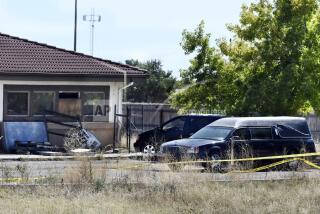Pierce Bros. Mortuaries Rapidly Expanding as High Overhead Closes Smaller Funeral Homes
- Share via
The growth of Pierce Bros. Mortuaries can be explained largely by the fact that just about once a month an independent, neighborhood funeral home in Southern California is given last rites.
Mortuary mortality is on the rise, brought on by high overhead and a trend toward lower-cost services such as cremations. As a result, morticians or their heirs find it hard to resist cashing in the land they own.
For the record:
12:00 a.m. Nov. 12, 1987 FOR THE RECORD
Los Angeles Times Thursday November 12, 1987 Home Edition Business Part 4 Page 2 Column 6 Financial Desk 2 inches; 42 words Type of Material: Correction
An article published Tuesday on Pierce Bros. Mortuaries incorrectly said the company’s owner, Joe Lewis Allbritton, was known for his failed attempt to keep the Washington Star newspaper alive. Actually, the Star was closed in 1981 by Time Inc., which bought the newspaper from Allbritton in 1978.
In increasing numbers, long-established mortuaries are closing or, more often, selling to chains such as North Hollywood-based Pierce Bros., which can spread overhead costs like $45,000 hearses and 24-hour-a-day staffs among several funeral homes. In Los Angeles County, the consolidation has thinned the number of mortuaries to about 180 now from more than 220 in 1980, according to Vital Statistic Analyses in Redondo Beach.
“It’s survival of the fittest through an adjustment to the reality of cost versus income,” said Ronald A. Hast, a Los Angeles mortician who publishes the industry trade publication Mortuary Management.
While the industry is contracting, Pierce Bros., the greater Los Angeles area’s largest chain, has been expanding quickly. In five years, it has grown from three cemeteries and 19 funeral homes to five cemeteries and 29 funeral homes that arrange 10,000 funeral services and cremations annually in Los Angeles and surrounding counties.
Glendale-based Forest Lawn, which has five cemeteries with mortuaries, may be better known because talk show host Johnny Carson jokes about it and because of its frequent celebrity burials.
Although Pierce Bros. cemeteries are the final resting spots for such celebrities as Marilyn Monroe, Natalie Wood and John Wayne, the company has sought to keep a low profile as a regional chain of community mortuaries maintaining long-established ties with families, even under corporate ownership.
“We’re your middle-class funeral homes,” Pierce Bros. President Thomas H. Johnson said. “Pierce Bros. is known as your neighborhood mortuary.”
The company was founded in Los Angeles in 1902 by brothers Edward, William, Fred and Robert Pierce, but it has been owned for nearly 30 years by one of the nation’s wealthiest men, Joe Lewis Allbritton, 62, who bought the business from the Pierce family.
A Houston broadcasting, banking and insurance executive best known for his failed attempt to keep alive the Washington Star newspaper, Allbritton has amassed a net worth estimated earlier this year by Forbes magazine at $575 million. Allbritton, who former executives say does not get involved in daily operations at Pierce Bros., operates the company through Pierce National Life, a Los Angeles funeral insurance company he owns. He declined to comment for this story.
As with most of Allbritton’s operations, Pierce Bros.’ financial details are secret. Competitors and former employees estimate its annual revenue at $12 million to $15 million, adding that profit margins in the industry typically range from 8% to 10% of sales.
The company’s revenue comes largely from funeral services, which cost an average of $1,547. A burial plot can cost an additional $300 to $900, while caskets range in price from $395 to $9,800.
In large part, competitors say, the firm’s expansion is due to the persuasiveness of Johnson, 38, an affable 6-foot, 4-inch native of Batesville, Ind., who attended Butler College on a baseball scholarship and still bats cleanup on a company softball team.
Rapid Changes
Johnson began working as a banker, then changed jobs to become a salesman for Hillenbrand Industries, a publicly held Batesville, Ind., company that is the nation’s largest casket maker.
“He has the ability to tactfully appeal to these long-term family businesses that have been around so long and get them to relinquish their operations into the fold of Pierce Bros.,” said Hast, who sold a mortuary in San Gabriel to Pierce Bros. last year.
Johnson said that although Pierce Bros. adds its name to a funeral home, it also keeps the old name to retain the neighborhood ties.
The fact that neighborhood mortuaries are selling out in greater numbers to Pierce Bros. and other chains is in many ways indicative of the rapid changes in the business of burying the dead.
Under a 1984 Federal Trade Commission rule, funeral homes must provide detailed prices to consumers and price information over the telephone. The rules came after the discovery of pricing abuses and high-pressure sales tactics by some funeral operators.
Families are increasingly choosing not to bury their loved ones in elaborate ceremonies, opting instead for less expensive cremation packages, often with no service provided by the funeral home.
At Pierce Bros., cremation packages cost from $474 to $1,195, with placement of remains running $75 for scattering at sea, $50 to be put in a Pierce Bros. garden or $40 to be shipped by registered mail to another city.
Last year 2.1 million Americans died. According to the Cremation Assn. of North America in Chicago, 14% of the bodies were cremated. Twenty years ago, the group said, cremation was a rarity. But in California, where cremation has been popular longer, more than one out of three corpses were cremated last year. Funeral executives say about half of the cremations are done without services.
Big Ad Campaigns
At the same time, funeral homes still maintain expensive overhead that is being used less, such as hearses, large parking lots, 24-hour-a-day staffs and buildings that are sometimes 10,000 square feet or more in size to house chapels and funeral rooms.
Concern over prices has resulted in big ad campaigns by mortuary chains to sell prepaid funeral plans, such as a $2,500 funeral in a contract structured much like a standard insurance policy. The money is invested to ensure that the funeral cost won’t rise.
Because of these pressures on small mortuaries, the temptation to sell their land is often too great to resist.
“It’s just not practical for a funeral home doing 150 cases a year to be housed in a facility that is worth a million dollars,” said Long Beach mortician Randall Stricklin, a member of the California Board of Funeral Directors and Embalmers regulatory agency.
As Pierce Bros. has expanded by acquisition, so too has its competition, chiefly Houston-based Service Corp. International. The company, known as SCI, is by far the nation’s largest chain with nearly 400 funeral homes and, like Pierce Bros., seeks to buy long-established family operations.
“A lot of small family businesses are beginning to realize they have a lot of money tied up underneath funeral homes that are not high volume businesses,” said John Morrow, a former Pierce Bros. president who chairs an advisory board for a subsidiary of SCI.
Regional Clusters
SCI has considerable financial strength of its own, as a publicly held company with sales this year estimated by securities analysts at more than $500 million and likely profit of $71 million. Although it lags behind Pierce Bros. in the Los Angeles area with 17 mortuaries, including Gates, Kingsley & Gates, and three cemeteries, SCI has gained a strong foothold in San Diego--an area Johnson considers ripe for Pierce Bros.’ expansion--and is weighing further expansion throughout Southern California.
“In almost every instance where there is a funeral home for sale, the sellers are being romanced by both SCI and Pierce Bros.,” Stricklin said.
Hast, the publisher of Mortuary Management, said Pierce Bros.’ long-term strategy is to buy homes, then consolidate them into regional clusters of homes, usually at cemetery locations.
“Once they have the momentum and the name identity of all these former mortuaries . . . then they will enjoy a more secure position with the major likelihood of eliminating competition,” Hast said.
More to Read
Inside the business of entertainment
The Wide Shot brings you news, analysis and insights on everything from streaming wars to production — and what it all means for the future.
You may occasionally receive promotional content from the Los Angeles Times.










